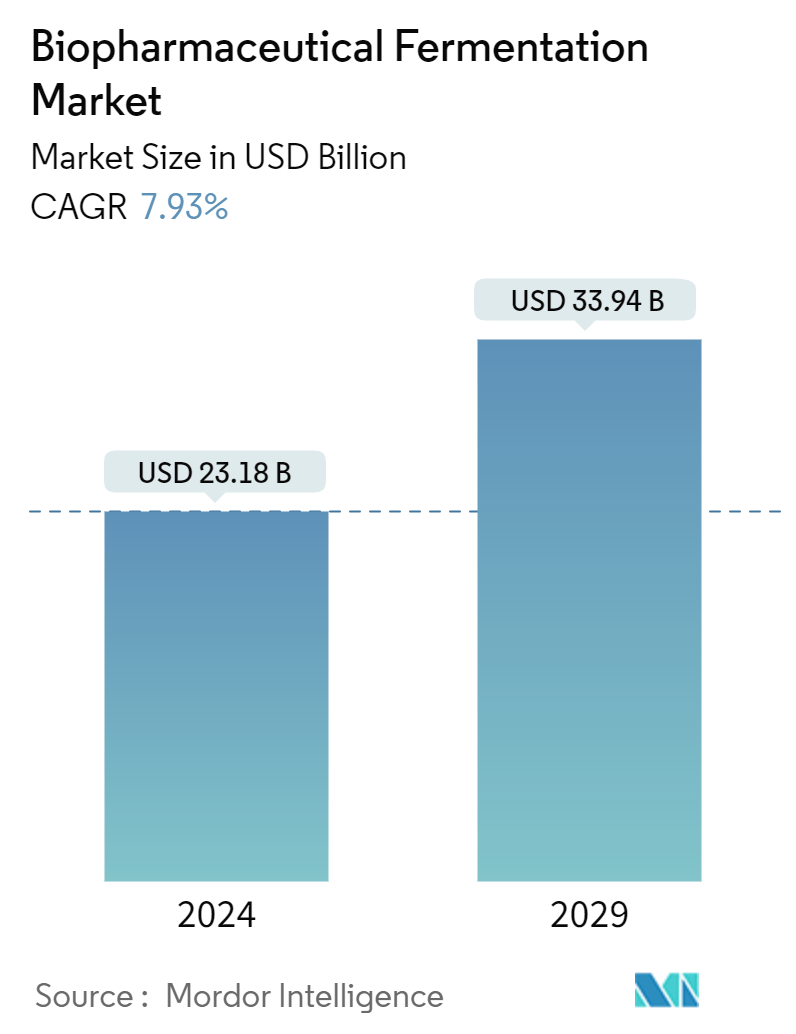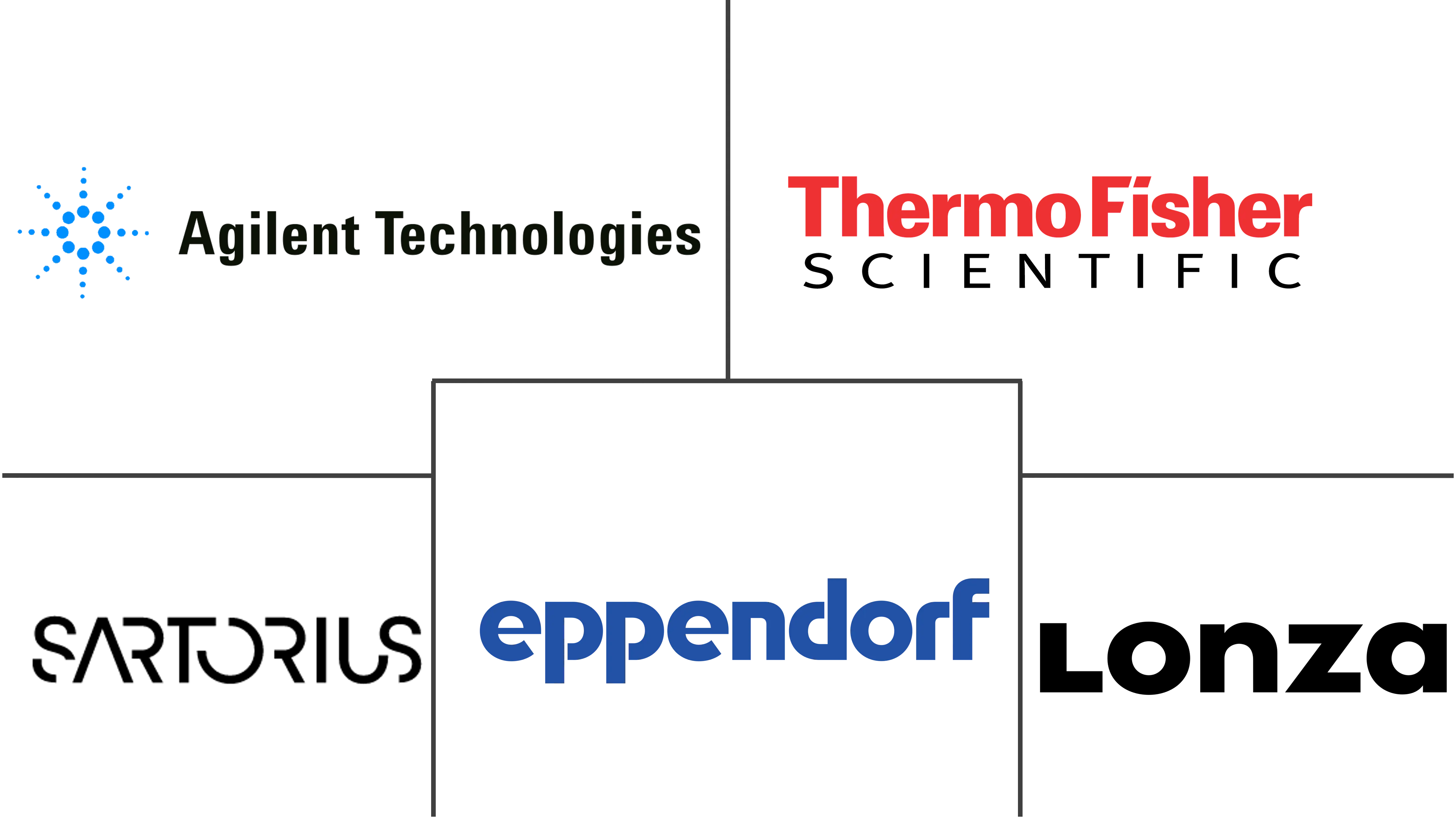Market Size of Biopharmaceutical Fermentation Industry

| Study Period | 2021 - 2029 |
| Market Size (2024) | USD 23.18 Billion |
| Market Size (2029) | USD 33.94 Billion |
| CAGR (2024 - 2029) | 7.93 % |
| Fastest Growing Market | Asia-Pacific |
| Largest Market | North America |
| Market Concentration | Low |
Major Players
*Disclaimer: Major Players sorted in no particular order |
Biopharmaceutical Fermentation Market Analysis
The Biopharmaceutical Fermentation Market size is estimated at USD 23.18 billion in 2024, and is expected to reach USD 33.94 billion by 2029, growing at a CAGR of 7.93% during the forecast period (2024-2029).
The market has seen a surge in demand due to the introduction of cost-effective biosimilars, enhancing the uptake of biotech-based drugs. Fermentation plays a pivotal role in producing the active substances of these drugs. For instance, a January 2024 report from MJH Life Sciences highlighted a notable increase in cancer-related products, with certain categories capturing an 80% share of biosimilars. Key players, through product launches and strategic initiatives, have further bolstered the adoption of these drugs. A case in point is Boehringer Ingelheim's October 2023 launch of an unbranded biosimilar version of AbbVie's Humira, priced at a striking 81% discount to the original.
The global rise in disease prevalence, such as cardiovascular issues, has driven the demand for biotech-based drugs. A January 2024 British Heart Foundation report noted that 7.6 million individuals in England and 620 million worldwide are grappling with cardiovascular diseases, a figure on the rise due to aging and lifestyle changes. This escalating demand for biotech drugs is poised to propel market growth.
Company initiatives, such as Eikonoklastes Therapeutics' November 2022 partnership with Forge Biologics for ALS-targeting gene therapy and Sanofi's August 2022 alliance with Janevent Biologics for oncology drugs, underscore the industry's momentum. These collaborations in biologics development leverage advanced biologics and innovative drug delivery systems to create more effective treatments. Such advancements are expected to boost demand for biopharmaceutical fermentation, driving market growth during the forecast period.
Consequently, factors like the escalating cancer burden and increased strategic activities by industry players are anticipated to fuel market growth. However, the high costs associated with biopharmaceutical fermentation and installations may temper this expansion.
Biopharmaceutical Fermentation Industry Segmentation
As per the scope of the report, biopharmaceutical fermentation systems, or bioprocessing, as the controlled incubation of microorganisms in enclosed tanks, managing aeration, agitation, temperature, and pH. The biopharmaceutical fermentation market is categorized by product type, applications, end users, and geography. Product types are divided into upstream and downstream categories. Upstream products encompass bioreactors/fermenters, bioprocess analyzers, and process monitoring systems. Downstream offerings include filtration and separation, chromatography, consumables and accessories, among others. Applications range from antibiotics and recombinant proteins to probiotics and more. End users consist of biopharmaceutical industries, contract research organizations (CROs), CDMOs, and academic research institutes. Geographically, the market spans North America, Europe, Asia-Pacific, the Middle East, Africa, and South America. The report also estimates market sizes and trends for 17 countries across these major regions, with sizing and forecasts based on revenue (USD) for each segment.
| By Product Type | ||||||
| ||||||
|
| By Application | |
| Antibiotics | |
| Recombinant Proteins | |
| Other Applications |
| By End User | |
| Biopharmaceutical Industries | |
| Contract Research Organization | |
| Acedemic Research Institutes | |
| Other End users |
| Geography | ||||||||
| ||||||||
| ||||||||
| ||||||||
| ||||||||
|
Biopharmaceutical Fermentation Market Size Summary
The biopharmaceutical fermentation market is poised for significant growth, driven by the increasing demand for biotech-based drugs and the rising focus on research and development activities aimed at producing novel biological drugs. The market's expansion is further supported by the heightened need for complex fermentation products, a demand that was amplified during the COVID-19 pandemic due to the surge in enzyme requirements for mRNA vaccines and diagnostic kits. The pandemic also accelerated the production of biologic drugs, contributing to the market's growth trajectory. Companies are increasingly engaging in strategic partnerships and collaborations to advance the development of biologic therapies, which is expected to further propel the demand for fermentation services and products. Despite the high costs associated with biopharmaceutical fermentation, the market is anticipated to grow, with the chromatography segment expected to witness significant advancements due to technological innovations and the introduction of new products.
North America is projected to experience substantial growth in the biopharmaceutical fermentation market, fueled by the rising demand for biotech-based drugs and increased research and development investments. The region's high prevalence of chronic diseases, such as diabetes and cancer, is driving the need for effective biological drugs, thereby boosting the market. Companies are actively pursuing various business strategies, including product launches, acquisitions, and expansions, to enhance their offerings in the biopharmaceutical sector. The market is characterized by a fragmented landscape with numerous global and regional players, contributing to its competitive nature. Strategic acquisitions and the introduction of advanced bioreactor technologies are expected to strengthen the market further, ensuring its robust growth over the forecast period.
Biopharmaceutical Fermentation Market Size - Table of Contents
-
1. MARKET DYNAMICS
-
1.1 Market Overview
-
1.2 Market Drivers
-
1.2.1 Increasing Demand for Biotech based Drugs
-
1.2.2 Rising Research and Development Activities to Produce Novel Biological Drugs
-
-
1.3 Market Restraints
-
1.3.1 High Cost of Biopharmaceutical Fermentation and its Installation
-
-
1.4 Porter's Five Force Analysis
-
1.4.1 Threat of New Entrants
-
1.4.2 Bargaining Power of Buyers/Consumers
-
1.4.3 Bargaining Power of Suppliers
-
1.4.4 Threat of Substitute Products
-
1.4.5 Intensity of Competitive Rivalry
-
-
-
2. MARKET SEGMENTATION (Market Size by Value - USD million)
-
2.1 By Product Type
-
2.1.1 Upstreams Products
-
2.1.1.1 Bioreactors/Fermentors
-
2.1.1.2 Bioprocess Analyzers
-
2.1.1.3 Process Monitoring System
-
2.1.1.4 Other Upstream Products
-
-
2.1.2 Downstream Products
-
2.1.2.1 Filtration and Seperation
-
2.1.2.2 Chromatography
-
2.1.2.3 Consumables and Acessories
-
2.1.2.4 Other Downstream Products
-
-
-
2.2 By Application
-
2.2.1 Antibiotics
-
2.2.2 Recombinant Proteins
-
2.2.3 Other Applications
-
-
2.3 By End User
-
2.3.1 Biopharmaceutical Industries
-
2.3.2 Contract Research Organization
-
2.3.3 Acedemic Research Institutes
-
2.3.4 Other End users
-
-
2.4 Geography
-
2.4.1 North America
-
2.4.1.1 United States
-
2.4.1.2 Canada
-
2.4.1.3 Mexico
-
-
2.4.2 Europe
-
2.4.2.1 Germany
-
2.4.2.2 United Kingdom
-
2.4.2.3 France
-
2.4.2.4 Italy
-
2.4.2.5 Spain
-
2.4.2.6 Rest of Europe
-
-
2.4.3 Asia-Pacific
-
2.4.3.1 China
-
2.4.3.2 Japan
-
2.4.3.3 India
-
2.4.3.4 Australia
-
2.4.3.5 South Korea
-
2.4.3.6 Rest of Asia-Pacific
-
-
2.4.4 Middle East and Africa
-
2.4.4.1 GCC
-
2.4.4.2 South Africa
-
2.4.4.3 Rest of Middle East and Africa
-
-
2.4.5 South America
-
2.4.5.1 Brazil
-
2.4.5.2 Argentina
-
2.4.5.3 Rest of South America
-
-
-
Biopharmaceutical Fermentation Market Size FAQs
How big is the Biopharmaceutical Fermentation Market?
The Biopharmaceutical Fermentation Market size is expected to reach USD 23.18 billion in 2024 and grow at a CAGR of 7.93% to reach USD 33.94 billion by 2029.
What is the current Biopharmaceutical Fermentation Market size?
In 2024, the Biopharmaceutical Fermentation Market size is expected to reach USD 23.18 billion.

